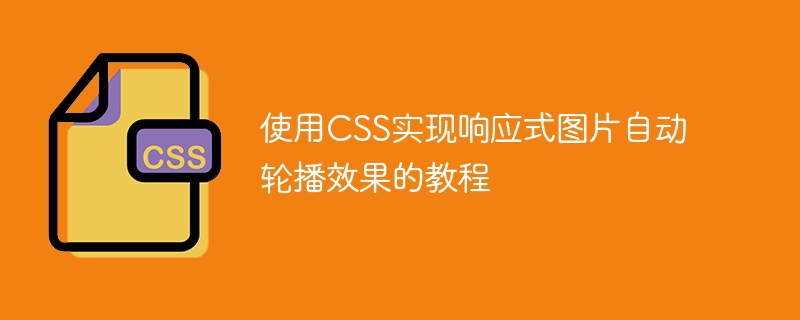

With the popularity of mobile devices, web design needs to take into account factors such as device resolution and screen size of different terminals to achieve a good user experience. When implementing responsive design of a website, it is often necessary to use the image carousel effect to display the content of multiple images in a limited visual window, and at the same time, it can also enhance the visual effect of the website. This article will introduce how to use CSS to achieve a responsive image automatic carousel effect, and provide code examples and analysis.
Implementation ideas
The implementation of responsive image carousel can be achieved through CSS flex layout. In a fixed container, set up a flex container to contain each image in a flex sub-container. Then by setting the arrangement of the flex sub-containers and the width of the sub-elements, the tiled arrangement of the pictures is achieved. However, because the width of the container will be different under different screen sizes, you need to use media queries to dynamically change the width of the container and sub-elements to adapt to different screen resolutions. Then by setting the animation effect of CSS3, the automatic carousel effect is realized, and the sliding effect is realized through js.
Implementation steps
First, we need to create a container containing multiple images in the HTML part, as shown below:
<div class="carousel-container">
<div class="carousel-items">
<img src="image1.jpg" alt="">
<img src="image2.jpg" alt="">
<img src="image3.jpg" alt="">
<img src="image4.jpg" alt="">
<img src="image5.jpg" alt="">
</div>
<div class="carousel-prev"></div>
<div class="carousel-next"></div>
</div>Among them, .carousel-container is the container style name, .carousel-items is the sub-container style name contained in the image, .carousel-prev and .carousel-next are the left and right arrow style names, we will use it in the CSS section Set style.
Next, we need to set the style in the CSS part, including the style of the container, sub-container and arrow. The specific code is as follows:
.carousel-container {
position: relative;
overflow: hidden;
width: 100%;
height: auto;
}
.carousel-items {
display: flex;
flex-wrap: nowrap;
width: 500%; /* 将子容器宽度扩大5倍 */
}
.carousel-items img {
width: 20%;
margin-right: 1rem;
flex: 1;
}
.carousel-prev,
.carousel-next {
position: absolute;
top: 50%;
transform: translateY(-50%);
width: 50px;
height: 50px;
background-color: rgba(0,0,0,0.5);
color: #fff;
text-align: center;
line-height: 50px;
cursor: pointer;
}
.carousel-prev {
left: 0;
}
.carousel-next {
right: 0;
}In the style definition, we set relative positioning for the container to achieve absolute positioning of subcontainers and arrows. Using overflow:hidden, you can hide the overflowing parts of sub-containers in the container. The sub-container adopts flex layout, and the nowrap attribute prevents the sub-container elements from wrapping. And set the width of the subcontainer to 500%. By setting the width of the pictures in the subcontainer to 20%, each row can display 5 pictures, and set the margin-right between pictures to 1rem to make the display effect more beautiful. The left and right arrows are centered vertically via absolute positioning and negative margin-top.
Under different screen sizes, the width of the container and sub-elements need to be dynamically changed to adapt to different screen resolutions. We can set responsive properties through media queries and change the width of the container and sub-containers under different screen sizes, as shown below:
/* 根据不同屏幕尺寸改变样式 */
@media (max-width: 768px) {
.carousel-items img {
width: 50%;
}
.carousel-container {
height: 250px;
}
}
@media (max-width: 480px) {
.carousel-items img {
width: 100%;
margin-right: 0;
}
.carousel-container {
height: 180px;
}
}In the above example, we set the carousel based on the window size change- items img and carousel-container styles. On a small screen, we set each image to 50% width, do not set margin-right between images, and set the height to 250px in the .crosso container; on a smaller screen, we set the image to 100% The width is set to 180px in the .crosso container.
Using CSS3 animation, you can achieve the automatic carousel effect of images. The code example is as follows:
@keyframes carousel-animation {
0% {
transform: translateX(0);
}
100% {
transform: translateX(-100%);
}
}
.carousel-items {
/* 动画设置 */
animation: carousel-animation 10s infinite linear;
}
.carousel-items:hover {
/* 鼠标悬停时终止动画 */
animation-play-state: paused;
}In the above example, we The picture subcontainer is set to scroll once every 10 seconds. The animation is completed by carousel-animation. Linear means the animation is linear, and infinite means the animation loops infinitely.
Finally, we use JavaScript to achieve the image sliding effect when the left and right arrows are clicked. The code example is as follows:
// 获取左右箭头元素
var prev = document.querySelector(".carousel-prev");
var next = document.querySelector(".carousel-next");
// 图片滚动函数
function carouselScroll(direction) {
var container = document.querySelector(".carousel-items");
var minScrollLeft = 0;
var maxScrollLeft = container.scrollWidth - container.clientWidth;
var increment = 20 * direction;
container.scrollLeft += increment;
if (container.scrollLeft < minScrollLeft) {
container.scrollLeft = maxScrollLeft;
} else if (container.scrollLeft > maxScrollLeft) {
container.scrollLeft = minScrollLeft;
}
};
// 给左右箭头绑定事件
prev.addEventListener("click", function() {
carouselScroll(-1);
});
next.addEventListener("click", function() {
carouselScroll(1);
});In the above example, we obtain the left and right arrow elements through querySelector and bind the click event. Use the carouselScroll function to achieve the picture sliding effect every time you click. container.scrollWidth represents the effective width of the sub-container, and container.clientWidth represents the visible width. When scrolling to the edge of the container, the scroll position will be set to the opposite position to achieve the effect of circular scrolling.
Summary
In this article, we used CSS3’s flex layout and animation effects, as well as JavaScript to implement the click events of the left and right arrows, and successfully implemented the responsive image automatic carousel effect. We also achieved a richer responsive design by adding media queries and hover effects. The code examples have a certain degree of generality and are also useful as a reference for beginners.
The above is the detailed content of Tutorial on using CSS to implement responsive image automatic carousel effect. For more information, please follow other related articles on the PHP Chinese website!